Jewellery and Buttons
A considerable amount of interest has been expressed in the jewellery made using Ruskin Pottery enamels.
The opportunity has been taken to study the use of these enamels both by jewellery manufacturers and by amateur makers in the often home-based Arts and Crafts environment. Judging by the number of new pieces discovered, the use of the Ruskin enamels was considerable, not so much at the upper end of the market using silver where the use of pottery enamels as against semi-precious stones was probably thought undesirable, but in the Home Arts and Industries sector using pewter.
The period in which such work was done was probably quite an extended one covering most of the lifetime of the factory, from the early years around 1901-2 to the late 1920’s or even the early 1930’s. The glazes used on the Ruskin Enamels were the standard production ones but also known are examples of flambé enamels, almost always mounted in silver. The early enamels using the standard soufflé glazes, often intermixed to resemble natural stones or even glass enamels, are particularly beautiful in effect while the lustre enamels include examples of the yellow and the orange glazes as well as examples of glazes developed after the First World War in the 1920’s such as the delphinium blue lustre. There are also examples of the ochre-blue soufflé developed in the period 1922-27 and matt-effect glazes of the late 1920’s to early 1930’s period. The collector has therefore a very wide range to choose from both in terms of glaze examples and types, colours and styles of mounting.
If the collector wishes only to have Ruskin pieces it is necessary here to issue a word of caution in that the undoubted popularity of the Ruskin enamels led other manufactures with a range of coloured glazes to offer a range of enamels as well. Marked examples are known from Moorcroft, Minton Hollins and Co. and the Kensington Art Pottery, but there are many unmarked examples and few match the Ruskin enamels in quality and richness of colour. From the point of view of the Ruskin collector it is better to avoid pieces which are unmarked or where the mark on the stone cannot be seen, except where the glaze makes the Ruskin manufacture a certainty, as in the High Fired pieces.
Associated with the manufacture of jewellery is the production by the Ruskin Pottery of ceramic buttons. These are often similar in shape and glaze to the enamels but have a small pottery shank moulded into the back to take the thread. The buttons were originally sold in sets attached to the cards and occasionally examples appear on the market but usually individual buttons are found. Again, other manufacturers made such buttons, including Pilkington’s, as well as the other firms mentioned above, and as buttons are not always marked, shape and glaze are important in determining manufacturer.
The History of Ruskin Jewellery
There are examples of roundels and hearts using the early soufflé glazes which employ the earthenware body known as ‘Tocky’ which fires to a rich golden colour. There are examples from the period around 1902 perhaps even earlier and some bear the small impressed ‘WHT’ monogram mark (for marks see ‘Ruskin Pottery ‘The Lost Catalogue’).
Although these may have initially been intended for mounting in domestic metalwork, caskets, light fittings etc. there is no reason which the pieces themselves dictate why they should not have been employed in jewellery. The earliest mention of the enamels is in an article in the Birmingham Daily Post which expands upon an article written for the January 1903 edition of the Pottery Gazette. The Daily Post article reported that, ‘A new departure is the preparation of small round plaques – “roundels”, varying from about three inches in diameter to the size of a small button. These are intended to be introduced as gems or points of colour in decorative woodwork and metal work.’
There is evidence however of production earlier than this in a roundel used in the lid of an inkwell made by Liberty and Co. with the Birmingham silver hallmark for 1901/2 and in a design for a white metal ‘button’ which bears a Registered Number 388979 dating it back to 1902. This design of a circular flower-form enclosing a central stone is known in various sizes used in the forms of brooches, hatpins and cloak clasps. It bears the Registered No. in an impressed oval and in another oval impressed ‘The Guild Button Ns.E.S.’ (See illustration).
From a slightly later period entries in the catalogue of the 12th Spring exhibition held in 1905 at the Cartwright Memorial Hall, Bradford indicate that the silversmith Bernard Cuzner of Bourneville, Birmingham, then just starting his career, mounted Ruskin enamels as included in the case of gold and silver wares which he exhibited were the following two items:
No. 678 Hammered Silver Buckle, Taylor Pottery 15s. 0d.
No. 682 Wrought Silver Buckle, Taylor Pottery 15s. 0d.
For comparison it may be noted that Mr. and Mrs. Arthur Gaskin had in the exhibition a Silver Clasp set Green Paste at £2. 2s. 0d. and the Bromsgrove Guild exhibited a Silver Buckle with peacock enamel for £4. 4s. 0d. It would seem therefore that the use of Taylor pottery enamels in silver was a cheaper option even against Green Paste. No examples of jewellery by Cuzner set with Ruskin enamels are now known.
Few silver items with maker’s marks have been recorded but it is known that from about the same time as the Bradford exhibition was taking place William Gilbert another Birmingham jeweller joined the firm of A. Edward Jones after it moved to its Windmill Street premises and that jewellery, some of it using the Taylors’ Ruskin enamels was included in their range. The catalogue of the London Arts and Crafts Exhibition Society of 1906 shows that pieces designed by W. Gilbert were exhibited as part of the A-Edward Jones display. Also in relation to this period an unpublished manuscript in the archives of A. Edward Jones Ltd. written by F.L. Temple, who also worked for Jones, entitled ‘A Short Account of the Start and Growth of St. Dunstan Silver Works’ related that “A selection of Ruskin productions was exhibited on the Continent and although the pottery as such did not gain an award at that time, one was given for the jewellery. One remember the humorous banter as to who should get the credit. Should Mr. Taylor or Mr. Jones or the designer Mr. Gilbert – or myself the workman who on that occasion produced it?”
One noted that although the pieces were made within the Jones establishment they had in fact been designed by W. Gilbert and apparently were made by various craftsmen of which Temple was one. A. Edward Jones is known also to have received help from, or to have been involved in various projects with Bernard Cuzner at this period.
There are quite a number of fine Ruskin enamels set as a brooch in a plain silver band or undecorated mount and these are usually either unmarked or marked only ‘silver’ or ‘sterling silver’. Other small silver items include a ring and earrings.
Buttons, plaques and jewellery formed an important part of Ruskin Pottery displays at exhibitions. The Pottery Gazette noted “…a collection of his very pretty ‘Ruskin’ buttons for ladies’ dresses…” at the Franco-British Exhibition in 1908 and in 1910 at the Ideal Home Exhibition observed “…in a case in the clothing section, Ruskin enamel buttons for dresses, sleeve-links and hat-pins, brooches, pendants, waist buckles, buttons etc. of Ruskin enamel mounted in silver…”.
In a 1909 advertisement in the Pottery Gazette it was claimed that “Buttons for dresses etc. are now in great demand”. The earliest exhibition of which we know where buttons were shown was the Leeds Arts and Crafts Exhibition of 1904 where 18 buttons were for sale at 10d each (2.5p) and again at the Leeds Spring show in 1905 there were two sets of six buttons at 3s. each (14.6p). The last major exhibition at which buttons were catalogued was the London Arts and Crafts Exhibition Society show in 1912 where a set of six buttons was still priced at 3s.
The Ruskin Pottery was, as noted, by no means the only firm to produce pottery buttons and in April 1919 the Pottery Gazette noted that Minton Hollins and Co. exhibited at the British Industries Fair “An interesting line of pottery buttons” along with a series of medallions suitable for mounting as brooches.
A further indiction of the popularity of Ruskin jewellery and the importance of these lines to Ruskin Pottery was the inclusion in its 1917 illustrated brochure of two full colour plates one of the stone mounted in gold, the other of unmounted enamels showing various glazes and colour effects. The use of gold is unusual and few extant pieces are known so it may be that Howson Taylor commissioned the pieces shown for the illustration. Included are a pendant, a bracelet and an example of an earring in two shapes – oval and lozenge. The caption to the second illustration comments that the enamels were “used for Buttons, Sleeve Links and hatpins, and for insertion in Metals, Wood etc”.
From this period a brooch design is known in a number of examples stamped with the Registration number 662862, the initials Ac and PLATINO. The design was registered in 1918 and is for a circular stone set in a square framed white-metal casting. The maker was Albert Carter and the PLATINO mark was also used by A.J. Pepper and Co. Ltd. Shrimpton and Co., whose mark was ‘S & Co’ produced brooches stamped PLATONDOR. In 1918 an alternative metal to platinum had been developed consisting of an alloy which was known under various names, OSMIOR, PLATOR, PLATINOV as well as the two above.
Ruskin Pottery itself in its next catalogue, produced in 1924 for the Empire Exhibition at Wembley still included plaques in its list of products “…also sleeve links and buttons in great variety and of colours to match ladies’ costumes, and enamels for insertion into jewellery, metal work and furniture.” Special card mounts were made to promote the brooches on offer. No Ruskin catalogues or exhibition catalogues are known after 1924 which list such items but a Ruskin pottery advertisement in The Studio of December 1931 mentions, but does not illustrate, “Ruskin stones in all shapes and colours.”
Ruskin Pottery glazes
Ruskin jewellery and buttons offer the collector the opportunity of putting together a completely representative selection of the glazes for which the company was famous. Some soufflé colours are rarely seen on vases or bowls but are encountered on the smaller items, roundels and plaques of various shapes. One rare glaze – the crystalline glaze known as aventurine which is of various tones of brown with crystalline specks embodied in it which sparkle and flash in sunlight – is occasionally found mounted as jewellery for which it is particularly suited but it is only otherwise known on a few small bowls, dishes and vases. Lustre glazes are on the other hand rarer in jewellery and the whole range of lustre colours does not appear to have been employed. Flambé, crystalline and matt glazes are also rare but examples can be found.
Range of wares
Brooches are the most usual form of jewellery using enamels round, square, rectangular, oval and hexagonal with a few tri-angular examples and some with heart-shaped enamels though these are surprisingly rare. Other items known or linked include pendants, bracelets, earrings, finger rings, hat-pins, scarf pins, buckles, cloak clasps and for men, sleeve-links (cufflinks) and studs, and a set of dress buttons is known.
Some roundels are made with a recessed back inset with a groove to take a circular, sprung wire attached to the pin. These roundels have an impressed mark.
RUSKIN
PAT
APP
FOR
Roundels and plaques are also known used in some more unusual items such as mirrored powder compacts and cigarette cases. It may be that pottery beads for threading were also made, presumably by the work people for their own use.
One further item is surely necessary for the collector of Ruskin jewellery and that is a jewel box or casket set with Ruskin hearts or gems. Many such boxes were made and range in type and price from the sheet pewter boxes made by the Arts and Crafts workers to fine examples in pewter and copper made by firms like Jesson & Birkett and Co. Ltd and A. Edward Jones.

A. E. Jones copper casket with Ruskin enamel. 
Former Jesson & Birkett design casket made by A. E. Jones.
A number of museums have examples of plaques, roundels, buttons and jewellery. One documentary group was acquired from Miss Rosemary Syson of Nuthall, Nottinghamshire by Nottingham Castle Museum in 1975 when the Dryden Street pewter shop owned by Mr. Edgar Hutchinson closed. The shop stock included a quantity of plaques some of which had been mounted in pewter as jewellery together with some of glass and a mother of pearl. These were kept in the large old-fashioned glass sweet jars shops used at the time. The Museum made a selection of 27 mounted and 39 unmounted pieces. Of the unmounted enamels 34 were marked RUSKIN, RUSKIN POTTERY or RUSKIN ENGLAND, 3 were marked ASTRA (for Minton Hollins and Co.) two including a 3” diameter orange one were unmarked. The jewellery included 13 with ceramic enamels which can only be assumed to be mostly Ruskin as the sheet pewter backs cover any marks, one was marked for Kensington and Art Ware C & L and 4 were mother for pearl. The collection also included a hair comb and a hat pin both with glass mounts.
The Ruskin glazes were the standard soufflé ones in blue, green, mauve pink or purple but also included orange and yellow lustre. One had a Kingfisher lustre glaze and was marked RUSKIN.

1917 Ruskin publicity brochure. 
Advertisement from Keswick magazine. 
Silver necklace with Ruskin enamels, circa 1905.
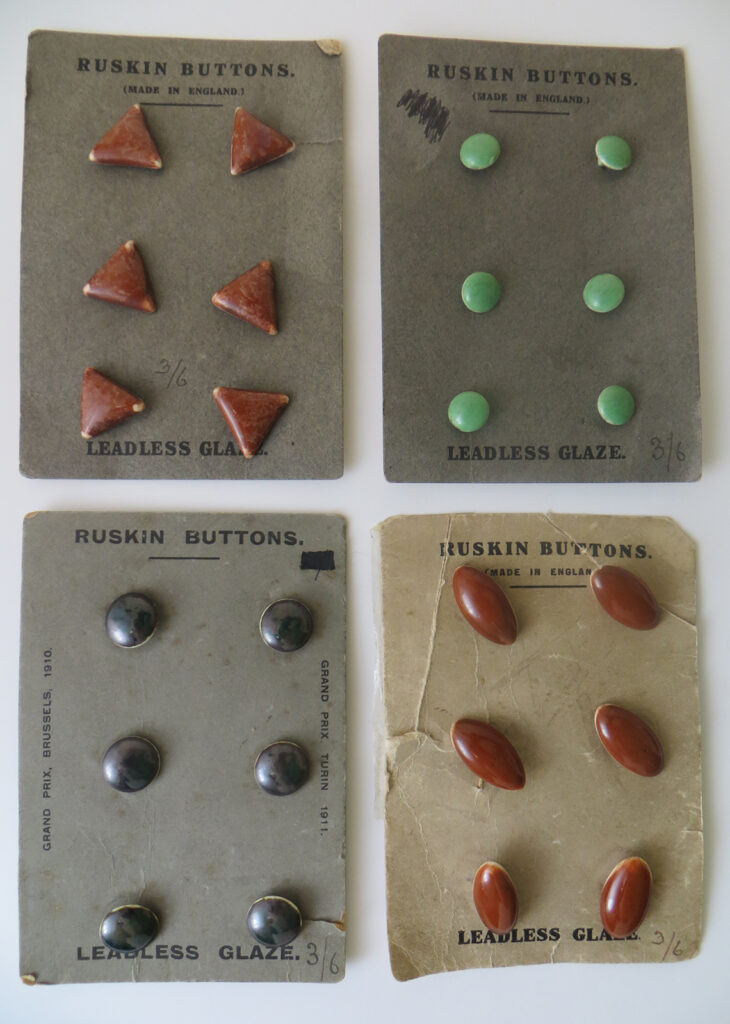
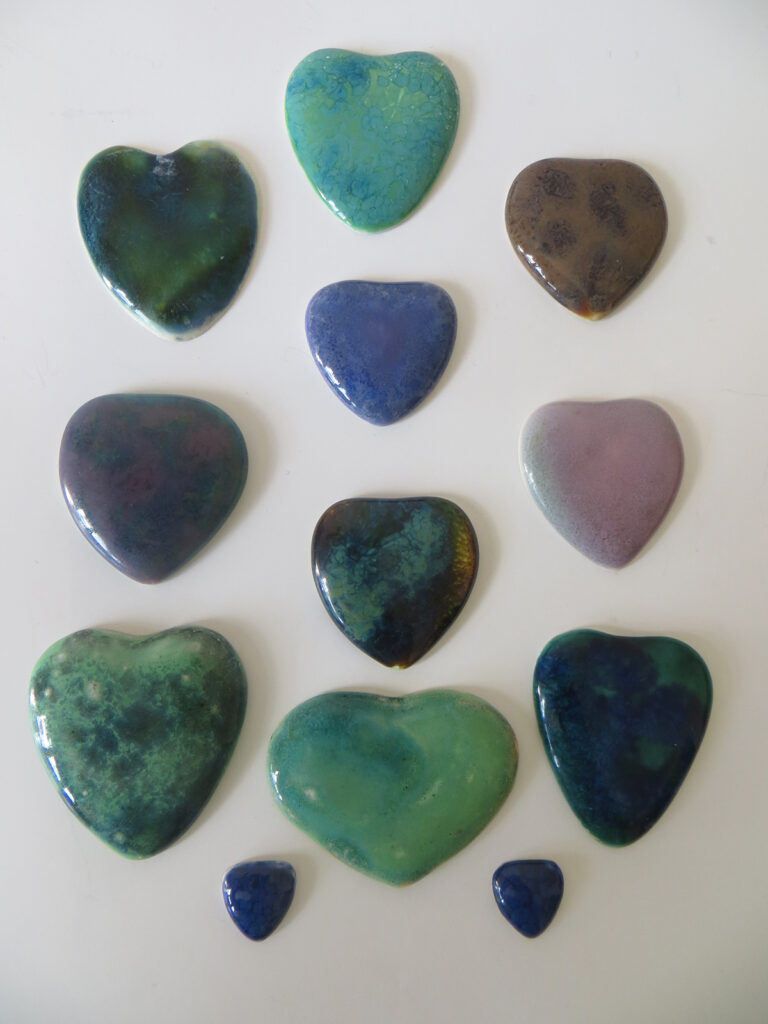
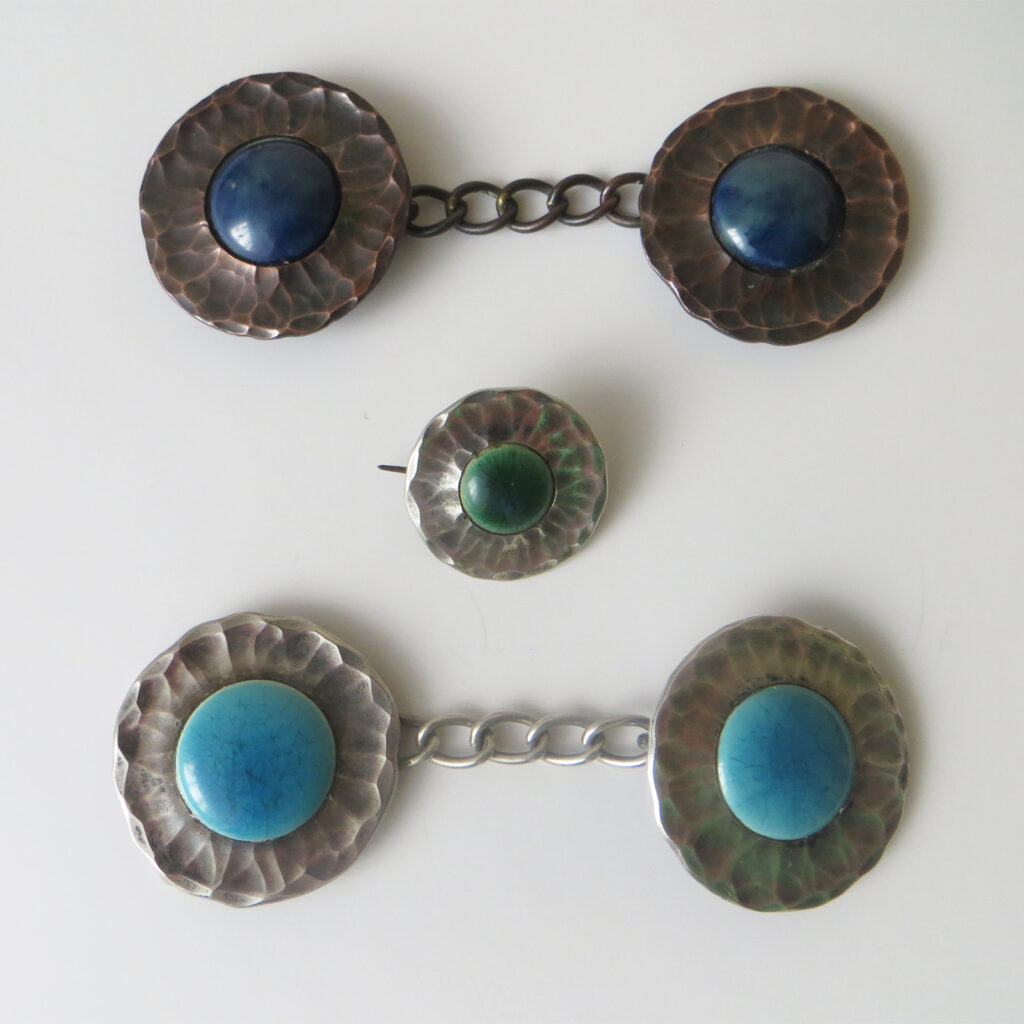
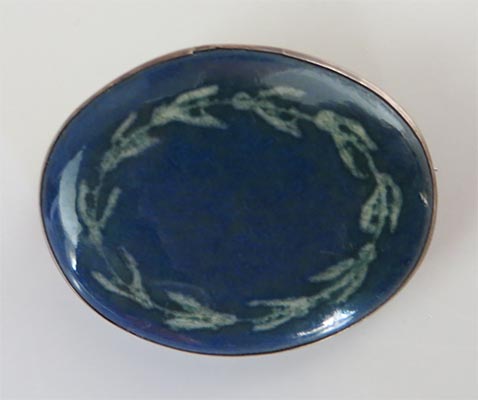
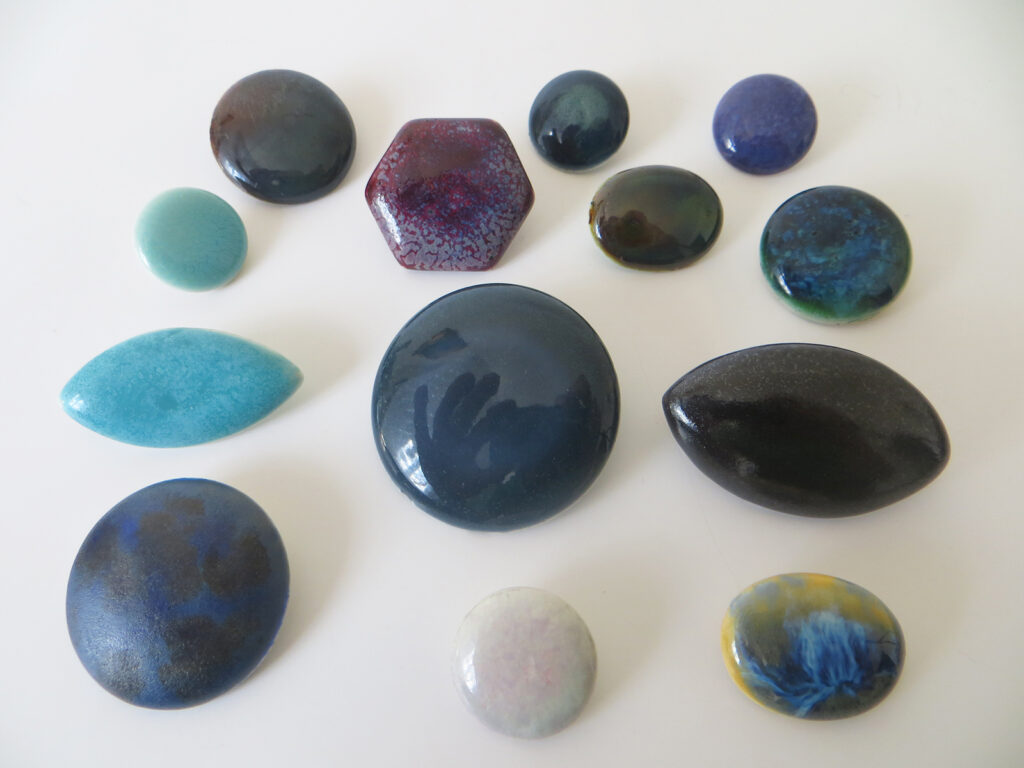
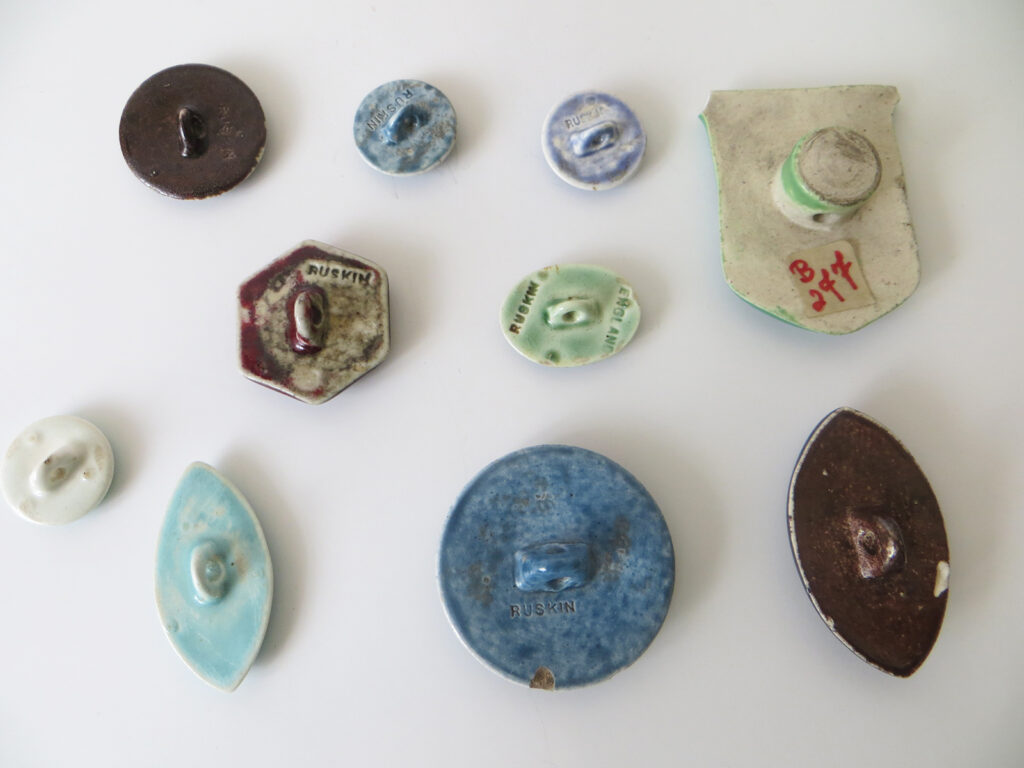
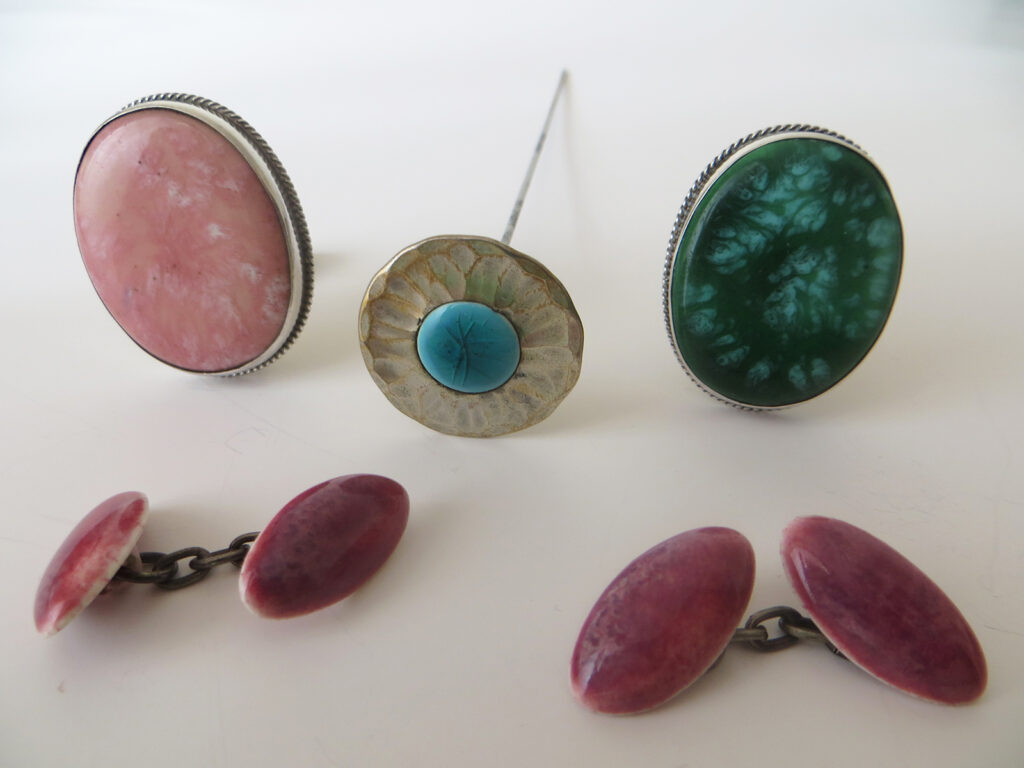
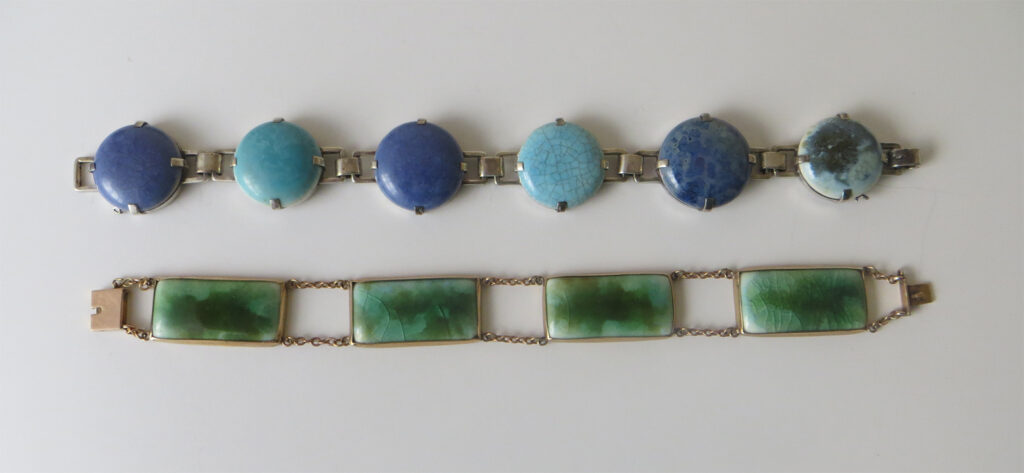
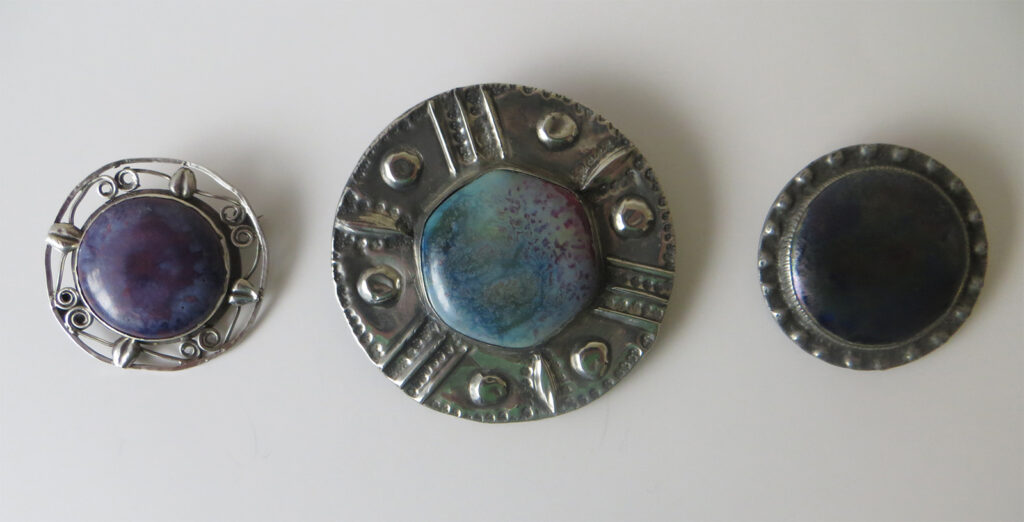
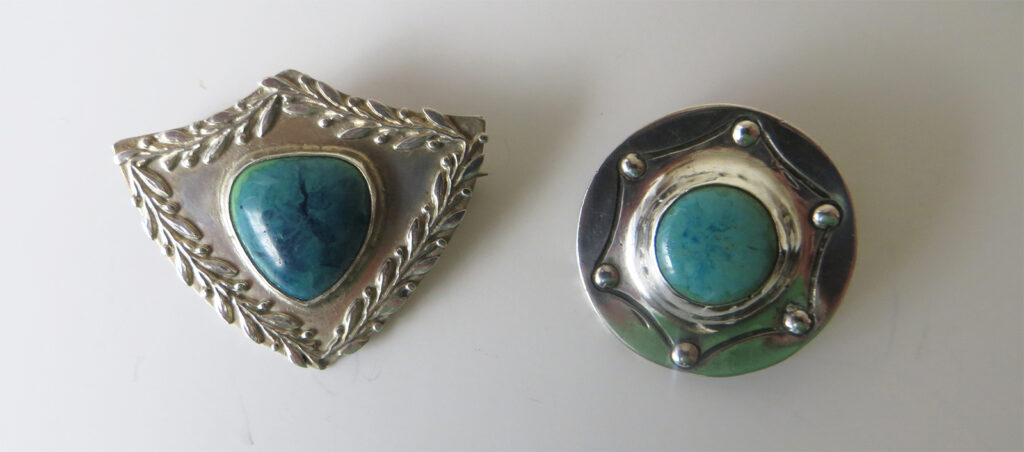
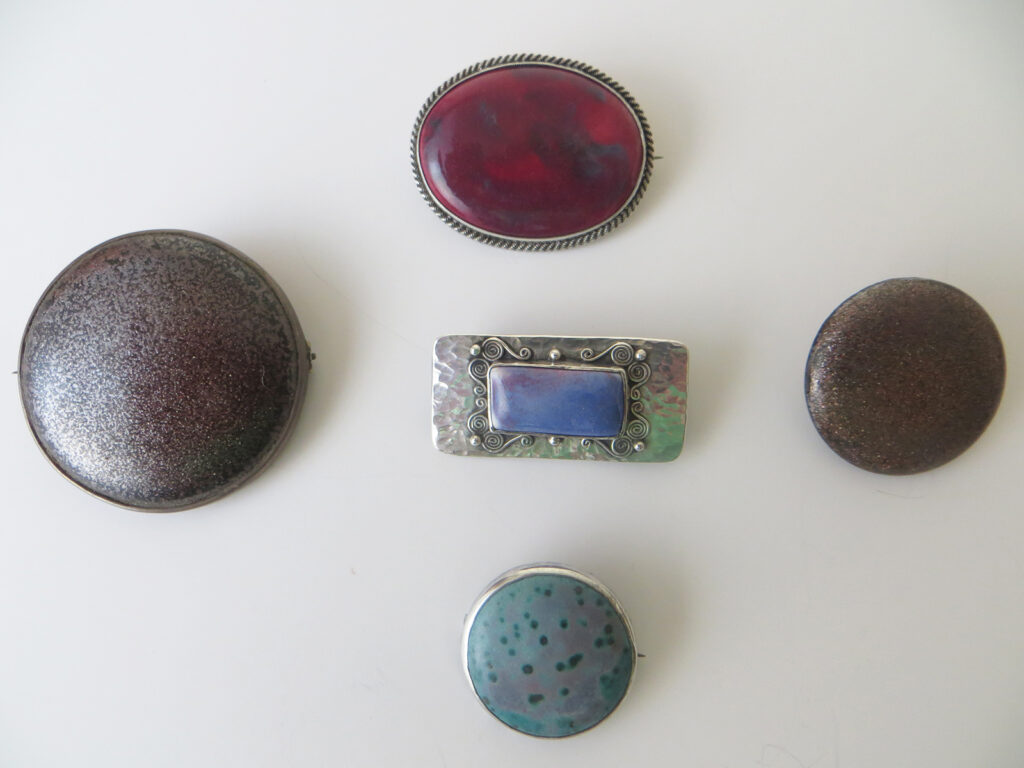
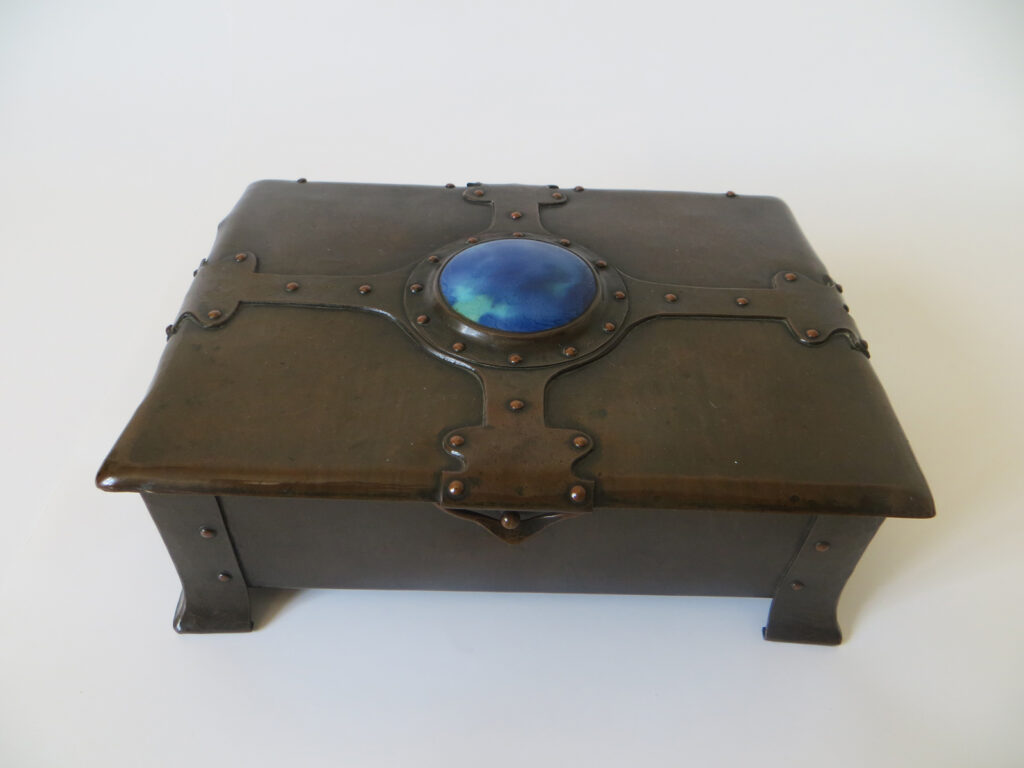
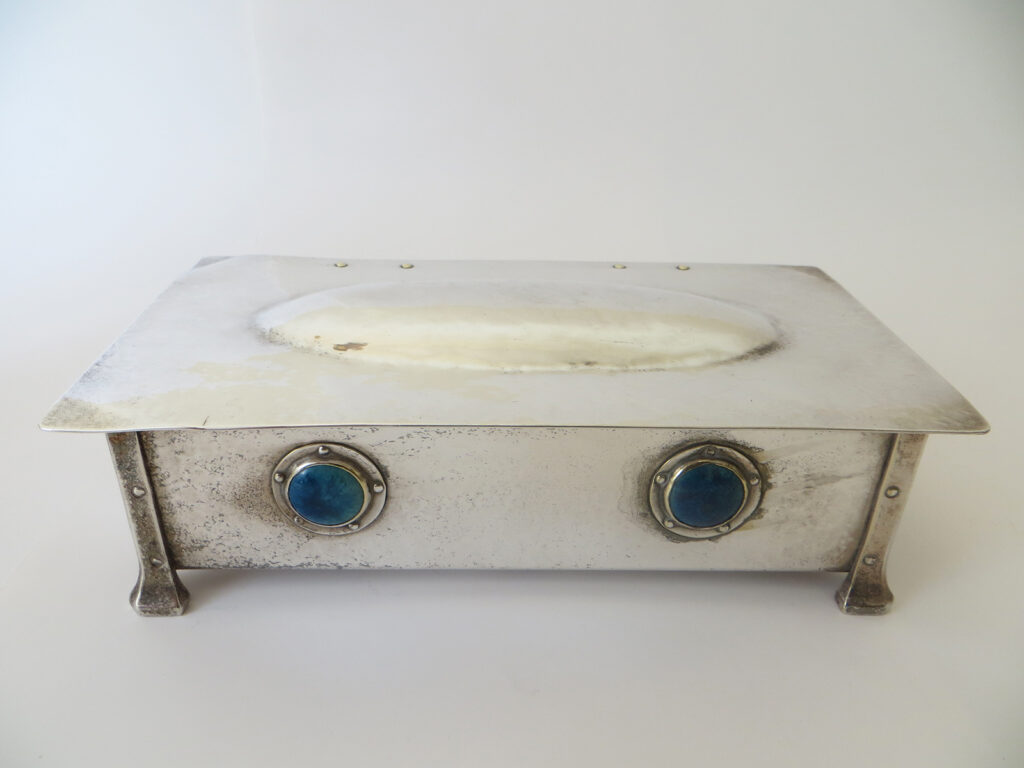
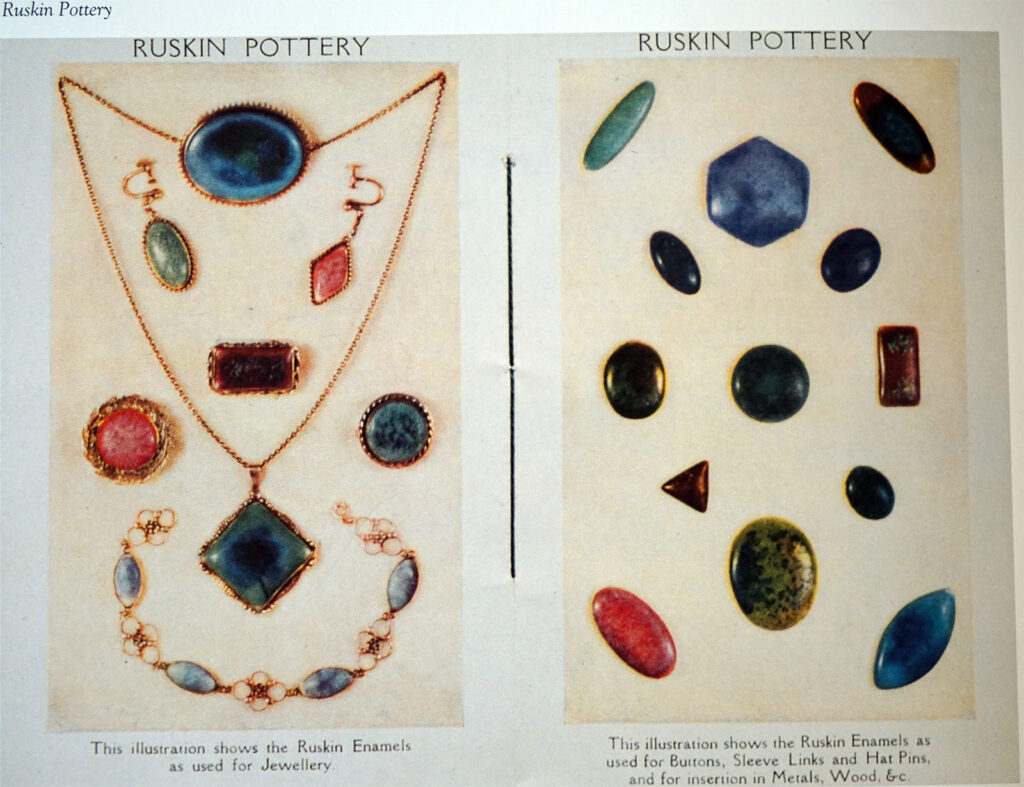
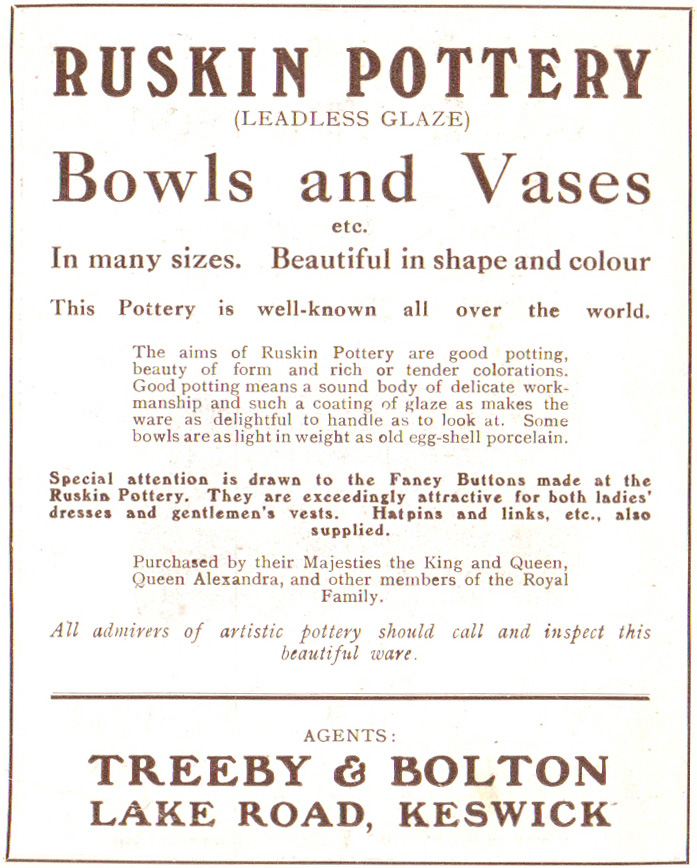
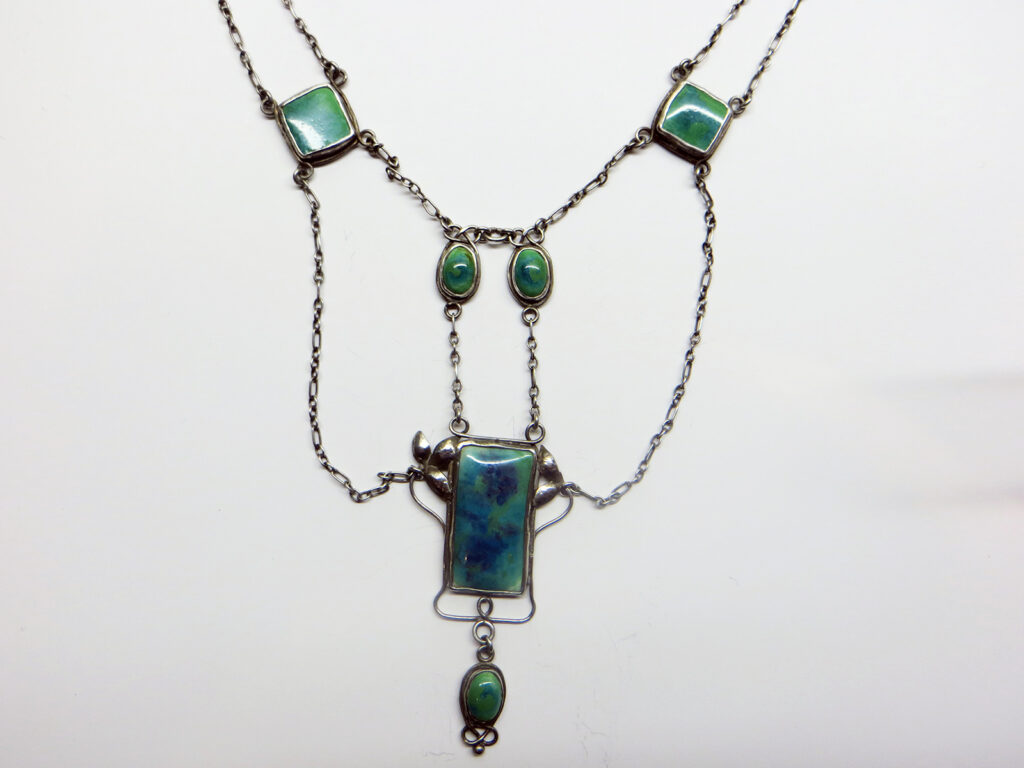
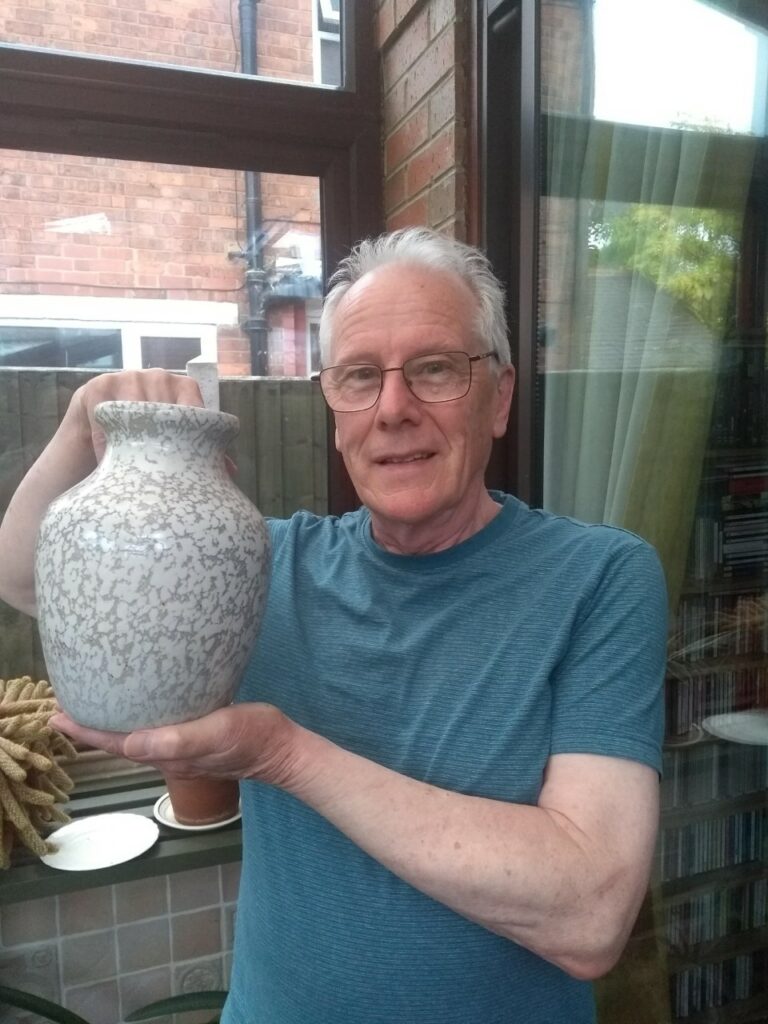
We have an arts and crafts copper mirror with 4 ceramic green hearts at the corners, which unfortunately we dropped and smashed the hearts. Is it possible to get replacements.
Thank you.
Hi Elaine ,yes you can get replacement hearts but 4 matching hearts will be difficult and also they vary in size
I have a guild brooch Ns.E.S registration number 388979.
With Ruskin green insert.
Just wanted to know the history. It’s been passed through the family
Norman and Ernest Spittle started working in Birmingham and produced hand beaten metalware.Guild buttons and broaches was the bread and butter of the trade ,registered design .1897-1907 and then the name changed
I am a button collector researching Ruskin buttons, specifically, what body was used to make the button. Were all buttons, made with the ‘Tocky’ clay? Are there Ruskin clothing buttons known to be made with a different body? If so, how would one identify them?
Hi Susan, Ruskin buttons were made from stoneware, Nearly all the time you would find it’s a white clay for buttons.
1898-1901 a local clay was used , which had a lot of impurities in and had a biscuit look to it known as “tocky clay” to my knowledge I have not seen buttons made at the factory with this clay , you’ll will see roundels.So it’s safe to say button’s came after1901 l would think buttons would have been sold on button cards and these date from1905 onwards.You do see roundels made up as buttons from outside sources ie Spittle brothers c1900s
I have a particularly large Ruskin jewel that was mounted in an English Art Nouveau sideboard. I dont see Ruskin roundels in furniture pieces as often, but in my particular case, it has a large center roundel and below it a flank of beautiful art nouveau ceramic tiles in complimentary glazes.
Hi Dave,must be a nice piece to live with,Many other companies jumped onto the Ruskin pottery bandwagon of producing roundels for furniture, metalwork, jewelry etc and it helped the potteries to tick over hard to tell if they are Ruskin as usually they are bedded into the items ,thanks
I have a white metal “The Guild Button” brooch with a Ruskin Green insert and looks like two white gods in a Wedgwood design by N & E.s Registered
No: 388978 . I would love to know more details about it if you can tell me anything please.
Thanks for sharing them Jane very unusual it’s a first for me
I don’t know where else to ask this question so I’m sorry if it’s not appropriate. Why do some Victorian Ruskin brooches with enamel centres and pewter wrap-overs have ‘painted’ backs. Thank you.
Hi Jeannine,it’s not my field but I would think it has something to do with the light entering the enamel and the painted back would reflect the colour back out giving it a dazzling effect as would silver foil backs on coloured glass broaches,not sure.
Hope you can help-Liberty of London sold a range of Pewter Brooches under the label PLANTAGENET at the beginning of 1900 with a Ruskin Cabochon roundel in the centre of each brooch, who was the manufacturer and indeed were they Ruskin Cabochons in the first place?any ideas would be much appreciated.I have found your website extremely informative excellent in all respects.
Hi Alan, ‘Plantagenet ‘was registered by
N&E Spittle of Birmingham mainly hand beaten broaches with Ruskin stones Thanks for looking and your comments are much appreciated